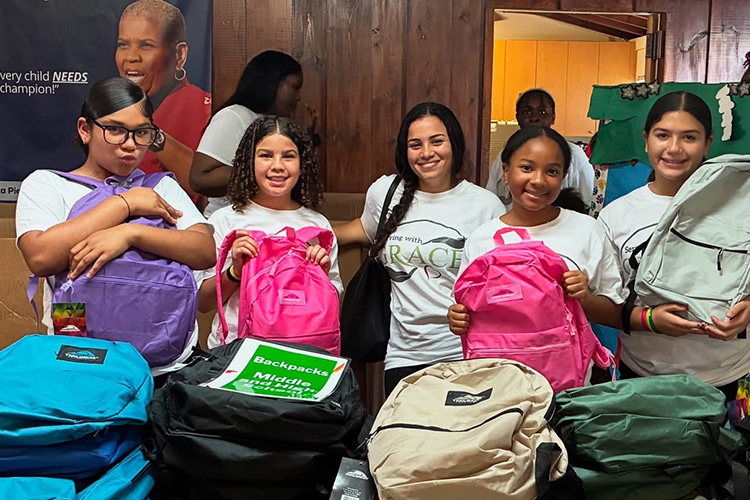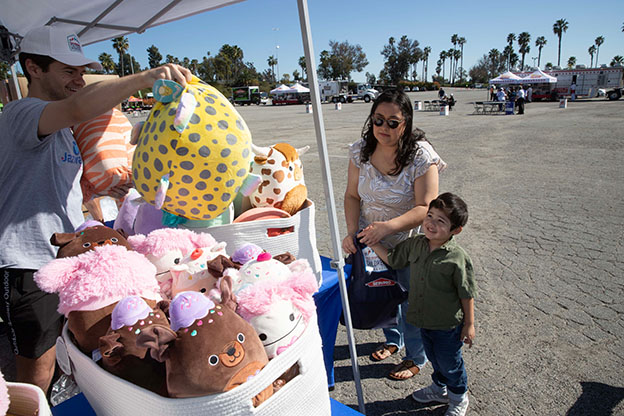In 2017, fast-moving wildfires ripped through Sonoma and Napa Counties in Northern California, claiming at least 10,000 homes and 40 lives.
The devastation prompted one local resident, a seasoned disaster relief volunteer and Spanish interpreter, to sign up to work at an evacuation shelter in Petaluma.
Karen Merzenich recalled how the shelter received a nonstop stream of in-kind donations throughout the day. By the time she left at 4 p.m., she had boxed up some 5,000 surplus toothbrushes, 3,000 sticks of deodorant, hundreds of gallons of hand sanitizer, and untold numbers of used blankets and sleeping bags.
All of this for a shelter with approximately 100 evacuees.
“I have seen this in every disaster I’ve worked,” Merzenich wrote in a personal essay titled, “Stop Donating Goods to Disaster Victims. What They Need Is Money.” “Sites languish for needed funds while they are literally drowning in unsolicited donations of goods. They can’t find volunteers to organize the stuff, nor space to store it. They can’t eat all of the donated food and have to leave it to rot. What an incredible waste…
“Imagine you have lost your home and everything in it, and what you get as a community is 50,000 sticks of men’s deodorant?”
The all-too-common scene that Merzenich describes here is what emergency relief professionals sometimes referred to as the “second disaster” — when literally tons of unwanted donations overwhelm a disaster zone. While very well-intentioned, these donations actually hinder the recovery effort by diverting relief workers away from more crucial tasks so they can sort through the heaps of used clothing, canned food, personal hygiene products, shoes, coats, blankets, and other odds and ends.
The donations clog shipping ports, airports, and emergency shelters, further hampering relief activities. They can even cost already cash-strapped countries and municipalities thousands or even millions of dollars to dispose of.
Here are some recent examples of waste in disaster giving:
- The war in Ukraine has prompted people from all over the world to send countless piles of clothes and other goods to the besieged country. But aid workers say much of it is junk, including items like used underwear, old toothbrushes, stilettos and mismatched slippers
- The Centers for Disease Control and Prevention released a statement discouraging people from donating baby formula after the recent shortage made national headlines. The CDC says you should not donate infant formula during natural disasters or other emergencies for a host of reasons, including lack of adequate storage and access to clean water
- After a string of tornadoes ripped through Kentucky in December 2021, disaster sites and shelters were overrun with unneeded donations. That disaster prompted Good360 to release recommendations for more thoughtful giving in disaster to the media
- At least 10 trailers stuffed with food, water and baby supplies donated for Hurricane Maria survivors were left to rot in a Puerto Rico parking lot
- Four shipping containers of baby food, clothes and medical supplies were destroyed after they were left abandoned four years after super typhoon Yolanda hit the Philippines
According to a study led by José Holguín-Veras, an expert on humanitarian logistics, 50 to 70 percent of the goods that arrive during emergencies is not needed or appropriate for the recovery nor the region.
Some of the most mismatched items sent during times of crisis, as cataloged by the United States Agency for International Development (USAID) and its Center for International Disaster Information (CIDI), include:
- weight-loss drinks and chandeliers donated after the Rwandan genocide of 1994
- prom gowns given to Honduras after Hurricane Mitch
- fertility drugs sent to the island nation after the 2010 Haiti earthquake
Understandably, people feel compelled to help in any way they can in the aftermath of a major disaster, driven by images and stories that they see in the media and in their social feeds. But what many don’t understand is that the vast majority of goods that get donated can be procured much more efficiently and cheaply from local sources.
For instance, the CIDI estimates that sending bottled water overseas can be 1,000 times more expensive than producing drinkable water locally. The organization has an excellent “greatest good calculator” that shows the true cost of sending, say, a $20 teddy bear from Los Angeles to Delhi, India. The answer: $165.85.
According to the calculator, if that $165.85 were given as a cash donation, it could be used by a relief organization to purchase 33,170 liters of clean water locally in Delhi. This would provide 16,585 people with 2 liters of clean drinking water for a day.
Cash donations also help in another crucial way — they allow nonprofit organizations to support and strengthen the local economy, whereas a flood of foreign goods that are free for the taking could end up hurting businesses in the community.
Here are some key considerations to think about when you want to help a community in need after a major disaster:
- Monetary donations are always the most useful and most effective way to give. Cash gives nonprofits the greatest flexibility to provide exactly the aid that’s needed. Support Good360 in our efforts as we are able to turn every dollar in donations into $20 in goods for communities in need
- In the vast majority of cases, your physical goods would be better off being donated to a local charity, church or assistance league (which would serve to help your own community should a disaster strike your area)
- Consider whether your donation of bottled water or used clothing could be obtained much faster, cheaper, and in more efficient quantities by local nonprofits and relief agencies on the ground. In almost all cases, the answer would be yes.
- If you are part of a company looking to make an in-kind donation, please contact Jim Alvey (JAlvey@Good360.org) at Good360 so we can discuss the best timing and placement for your goods. We have an entire team to assist with disaster recovery donations so that the right goods get to the right people at the right time.
- If you happen to live in or near an affected area, contact your local shelter, food bank, or community organization and ask what they actually need before making a donation.
Most importantly, don’t stop giving just because the disaster has moved off the front pages. It often takes years for communities to recover from a major natural disaster. Support is needed through the long slog of disaster recovery. This is also an excellent reason to continually give to your favorite nonprofits, not just when disaster strikes. Your long-term support builds up communities so that they’re more resilient when a catastrophe does occur.
Join us in making a meaningful impact!
For every $1 donated, Good360 can distribute AT LEAST $20 in needed goods. Donate to Good360 today!
Companies ready to make donations should contact: Jim Alvey, Director of Partnerships, Disaster Recovery, at jalvey@good360.org
Corporate donors should also consider signing our Resilient Response pledge, which encourages companies to donate responsibly and more strategically to drive more sustainable change.








